Determining the Appropriate Minimum Effort Levels for Use in Fisheries Dynamic Bioeconomic Models
Abstract
:1. Introduction
2. Materials and Methods
2.1. Definition of Key Concepts
- Revenue is the value of the catch (price times quantity);
- Variable costs are the costs directly related to the level of fishing activity and catch (e.g., fuel, crew costs, freight and packaging);
- Fixed costs are the costs that are incurred independently of the level of fishing activity (e.g., management levies, insurance, accountancy, boat maintenance, etc.);
- Net revenue is revenue minus variable costs;
- Profits are revenue minus both fixed and variable costs;
- The breakeven level of effort is the minimum number of fishing days (and the associated net revenue) required for profits to be greater than or equal to zero.
2.2. Breakeven Analysis
2.3. Historic Effort Levels
2.4. Testing the Different Threshold Effort Levels Using the Bioeconomic Model
3. Results
3.1. Breakeven Analysis
3.1.1. Analysis of Cost and Earnings Data
3.1.2. Breakeven Regression Analysis
3.2. Historic Effort Levels
3.3. Bioeconomic Model Results
4. Discussion and Conclusions
Author Contributions
Funding
Institutional Review Board Statement
Data Availability Statement
Conflicts of Interest
References
- Stephenson, R.L.; Wiber, M.; Paul, S.; Angel, E.; Benson, A.; Charles, A.; Chouinard, O.; Edwards, D.; Foley, P.; Lane, D.; et al. Integrating diverse objectives for sustainable fisheries in Canada. Can. J. Fish. Aquat. Sci. 2019, 76, 480–496. [Google Scholar] [CrossRef]
- Hornborg, S.; van Putten, I.; Novaglio, C.; Fulton, E.A.; Blanchard, J.L.; Plagányi, É.; Bulman, C.; Sainsbury, K. Ecosystem-based fisheries management requires broader performance indicators for the human dimension. Mar. Policy 2019, 108, 103639. [Google Scholar] [CrossRef]
- Thébaud, O.; Nielsen, J.R.; Motova, A.; Curtis, H.; Bastardie, F.; Blomqvist, G.E.; Daurès, F.; Goti, L.; Holzer, J.; Innes, J.; et al. Integrating economics into fisheries science and advice: Progress, needs, and future opportunities. ICES J. Mar. Sci. 2023, 80, 647–663. [Google Scholar] [CrossRef]
- Clark, C. Mathematical Bioeconomics; John Wiley & Sons: New York, NY, USA, 1976. [Google Scholar]
- Andersen, P.; Sutinen, J.G. Stochastic Bioeconomics: A Review of Basic Methods and Results. Mar. Resour. Econ. 1984, 1, 117–136. [Google Scholar] [CrossRef]
- Steinshamn, S.I. A Conceptional Analysis of Dynamics and Production in Bioeconomic Models. Am. J. Agric. Econ. 2011, 93, 803–812. [Google Scholar] [CrossRef]
- Larkin, S.L.; Alvarez, S.; Sylvia, G.; Harte, M. Practical Considerations in Using Bioeconomic Modelling for Rebuilding Fisheries; OECD Food, Agriculture and Fisheries Papers, No. 38; OECD Publishing: Paris, France, 2011. [Google Scholar]
- Merino, G.; Maynou, F.; García-Olivares, A. Effort dynamics in a fisheries bioeconomic model: A vessel level approach through Game Theory. Sci. Mar. 2007, 71, 537–550. [Google Scholar] [CrossRef]
- Bartelings, H.; Hamon, K.G.; Berkenhagen, J.; Buisman, F.C. Bio-economic modelling for marine spatial planning application in North Sea shrimp and flatfish fisheries. Environ. Model. Softw. 2015, 74, 156–172. [Google Scholar] [CrossRef]
- Punt, A.E.; Deng, R.A.; Dichmont, C.M.; Kompas, T.; Venables, W.N.; Zhou, S.; Pascoe, S.; Hutton, T.; Kenyon, R.; van der Velde, T.; et al. Integrating size-structured assessment and bioeconomic management advice in Australia’s northern prawn fishery. ICES J. Mar. Sci. 2010, 67, 1785–1801. [Google Scholar] [CrossRef]
- Vergara-Solana, F.J.; Vargas-López, V.G.; Bolaños-Durán, E.; Paz-García, D.A.; Almendarez-Hernández, L.C. Bioeconomic analysis of stock rebuilding strategies for the green abalone fishery in Mexico under climate uncertainty. Ocean Coast. Manag. 2023, 243, 106759. [Google Scholar] [CrossRef]
- Bhat, M.G.; Bhatta, R. Mechanization and technical interactions in multi-species Indian fisheries: Implications for economic and biological sustainability. Mar. Policy 2006, 30, 237–248. [Google Scholar] [CrossRef]
- Jardim, E.; Urtizberea, A.; Motova, A.; Osio, C.; Ulrich, C.; Millar, C.; Mosqueira, I.; Poos, J.J.; Virtanen, J.; Hamon, K.J.J.S. Bioeconomic Modelling Applied to Fisheries with R/FLR/FLBEIA; JRC Scientific Policy Report EUR 25823 EN; Joint Research Centre: Ispra, Italy, 2013. [Google Scholar]
- Hoff, A.; Frost, H. Modelling combined harvest and effort regulations: The case of the Dutch beam trawl fishery for plaice and sole in the North Sea. ICES J. Mar. Sci. 2008, 65, 822–831. [Google Scholar] [CrossRef]
- Péreau, J.C.; Doyen, L.; Little, L.R.; Thébaud, O. The triple bottom line: Meeting ecological, economic and social goals with individual transferable quotas. J. Environ. Econ. Manag. 2012, 63, 419–434. [Google Scholar] [CrossRef]
- Martinet, V.; Thébaud, O.; Doyen, L. Defining viable recovery paths toward sustainable fisheries. Ecol. Econ. 2007, 64, 411–422. [Google Scholar] [CrossRef]
- Gourguet, S.; Macher, C.; Doyen, L.; Thébaud, O.; Bertignac, M.; Guyader, O. Managing mixed fisheries for bio-economic viability. Fish. Res. 2013, 140, 46–62. [Google Scholar] [CrossRef]
- Cissé, A.A.; Gourguet, S.; Doyen, L.; Blanchard, F.; Péreau, J.C. A bio-economic model for the ecosystem-based management of the coastal fishery in French Guiana. Environ. Dev. Econ. 2013, 18, 245–269. [Google Scholar] [CrossRef]
- AFMA. Northern Prawn Fishery Harvest Strategy 2022; Australian Fisheries Management Authority: Canberra, Australia, 2022. [Google Scholar]
- Australian Fisheries Management Authority. Northern Prawn Fishery Resource Assessment Group (NPRAG) Meeting Minutes, May 2008; Australian Fisheries Management Authority: Canberra, Australia, 2008. [Google Scholar]
- Dichmont, C.M.; Jarrett, A.; Hill, F.; Brown, M. Harvest Strategy for the Northern Prawn Fishery under Input Controls; Report to the Australian Fisheries Management Authority, Project 2006/828; CSIRO: Brisbane, Australia, 2012. [Google Scholar]
- Australian Fisheries Management Authority. Northern Prawn Fishery Resource Assessment Group (NPRAG) Meeting Minutes, 17–18 May 2022; Australian Fisheries Management Authority: Canberra, Australia, 2022. [Google Scholar]
- Vance, D.J.; Rothlisberg, P.C. Chapter One—The biology and ecology of the banana prawns: Penaeus merguiensis de Man and P. indicus H. Milne Edwards. Adv. Mar. Biol. 2020, 86, 1–139. [Google Scholar] [PubMed]
- Vance, D.J.; Staples, D.J.; Kerr, J.D. Factors affecting year-to-year variation in the catch of banana prawns (Penaeus merguiensis) in the Gulf of Carpentaria, Australia. ICES J. Mar. Sci. 1985, 42, 83–97. [Google Scholar] [CrossRef]
- Zeileis, A.; Kleiber, C.; Jackman, S. Regression Models for Count Data in R. J. Stat. Softw. 2008, 27, 1–25. [Google Scholar] [CrossRef]
- R Core Team. R: A Language and Environment for Statistical Computing; R Foundation for Statistical Computing: Vienna, Austria, 2023. [Google Scholar]
- Meteyard, B. Northern Prawn Fishery Data Summary 2022; NPF Industry Pty Ltd., Australian Fisheries Management Authority: Canberra, Australia, 2023. [Google Scholar]
- Deng, R.A.; Miller, M.; Upston, J.; Hutton, T.; Moeseneder, C.; Punt, E.A.; Pascoe, S. Status of the Northern Prawn Fishery Tiger Prawn Fishery at the End of 2021 with Estimated TAEs for 2022 and 2023; Report to the Australian Fisheries Management Authority, October 2022. AFMA Project No. 2020/0803; Australian Fisheries Management Authority: Canberra, Australia, 2022. [Google Scholar]
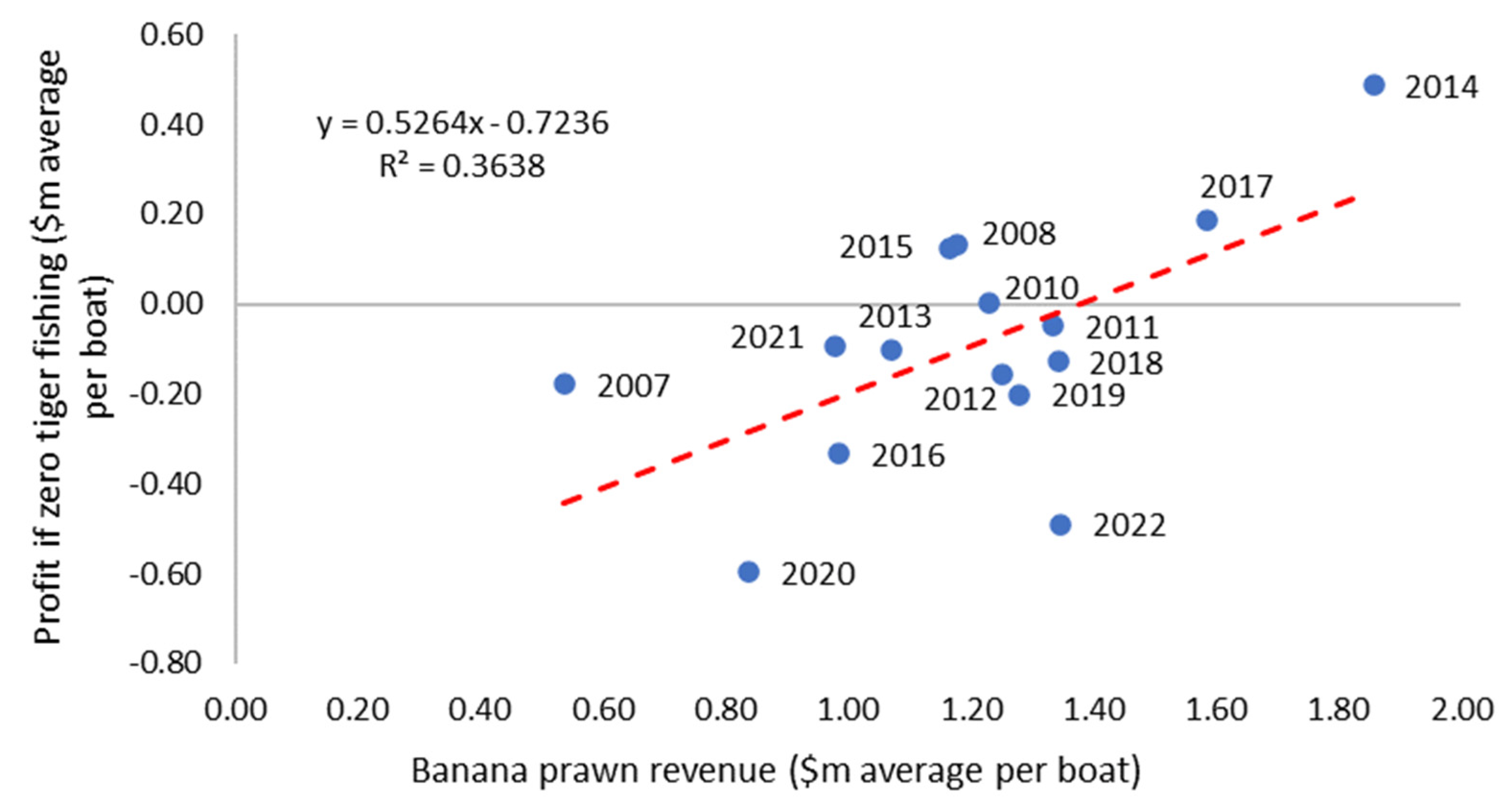

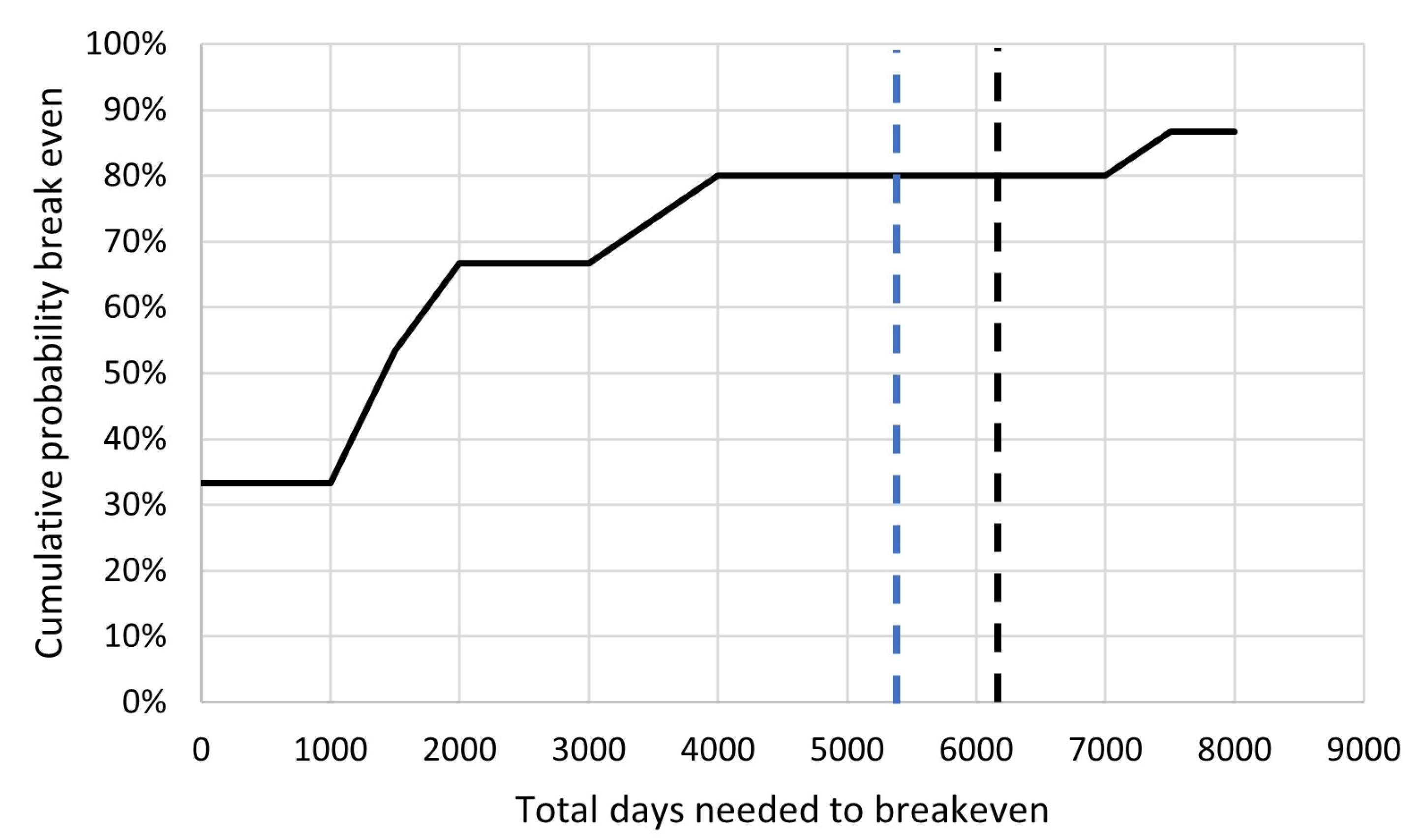
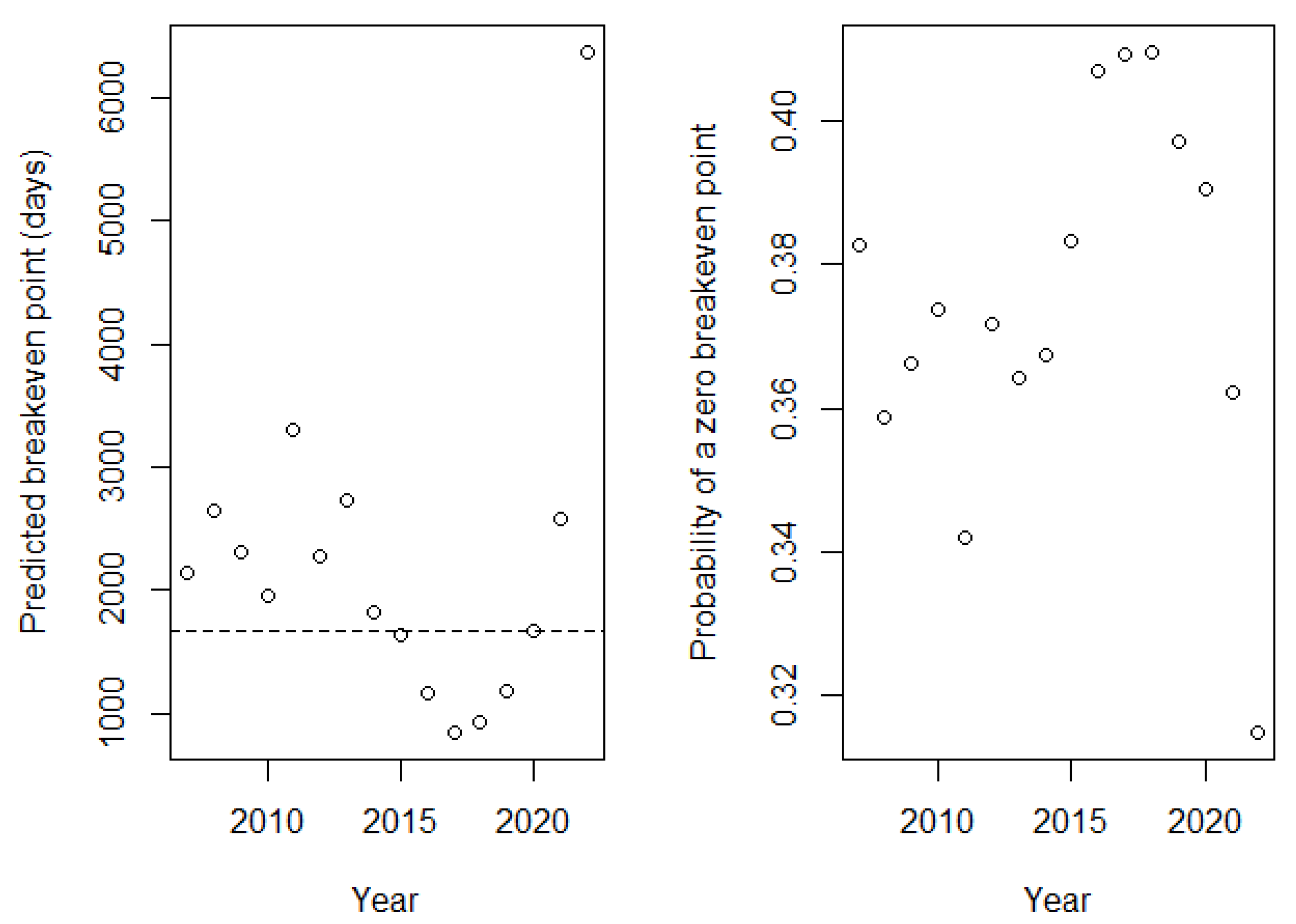


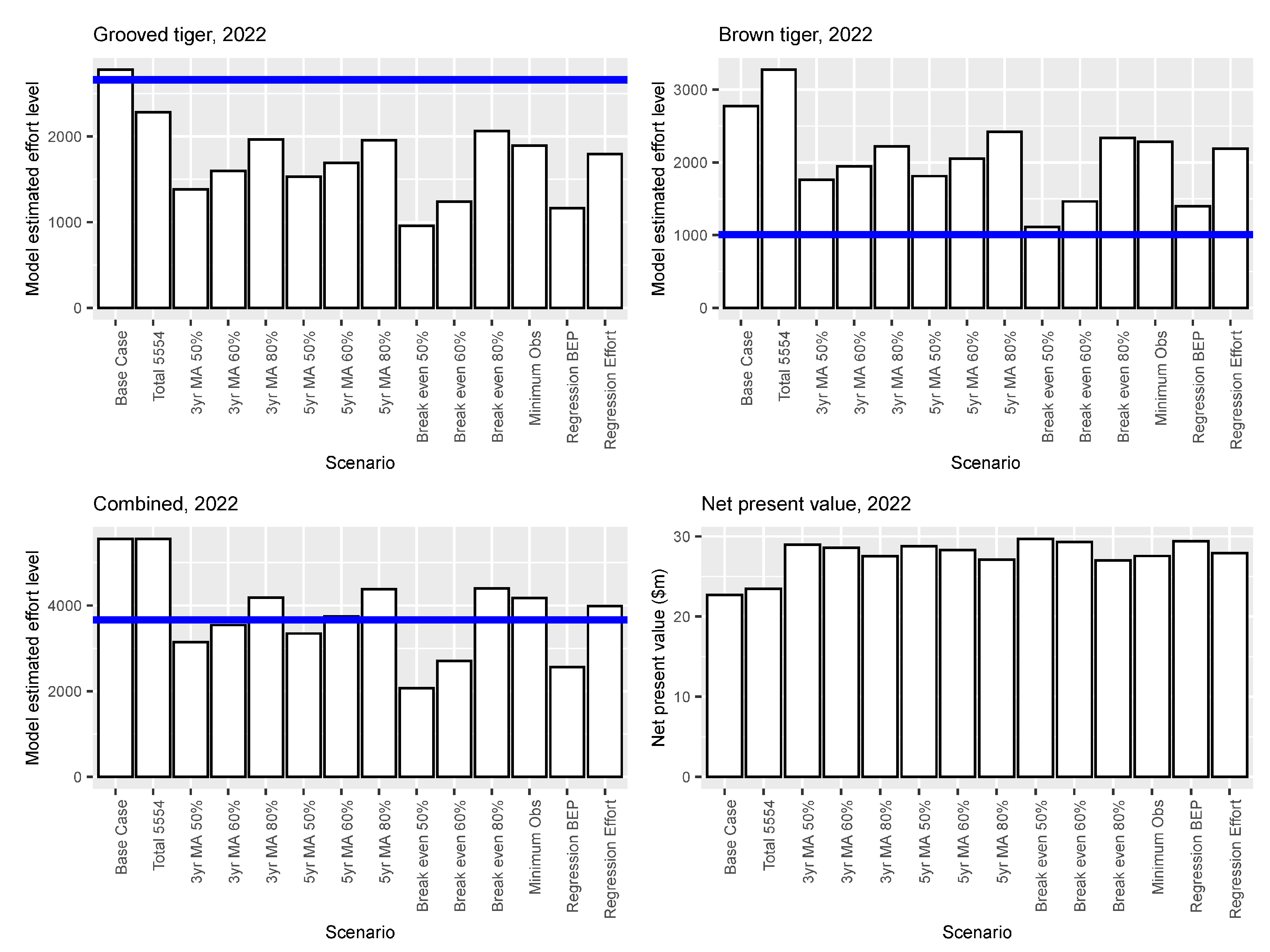
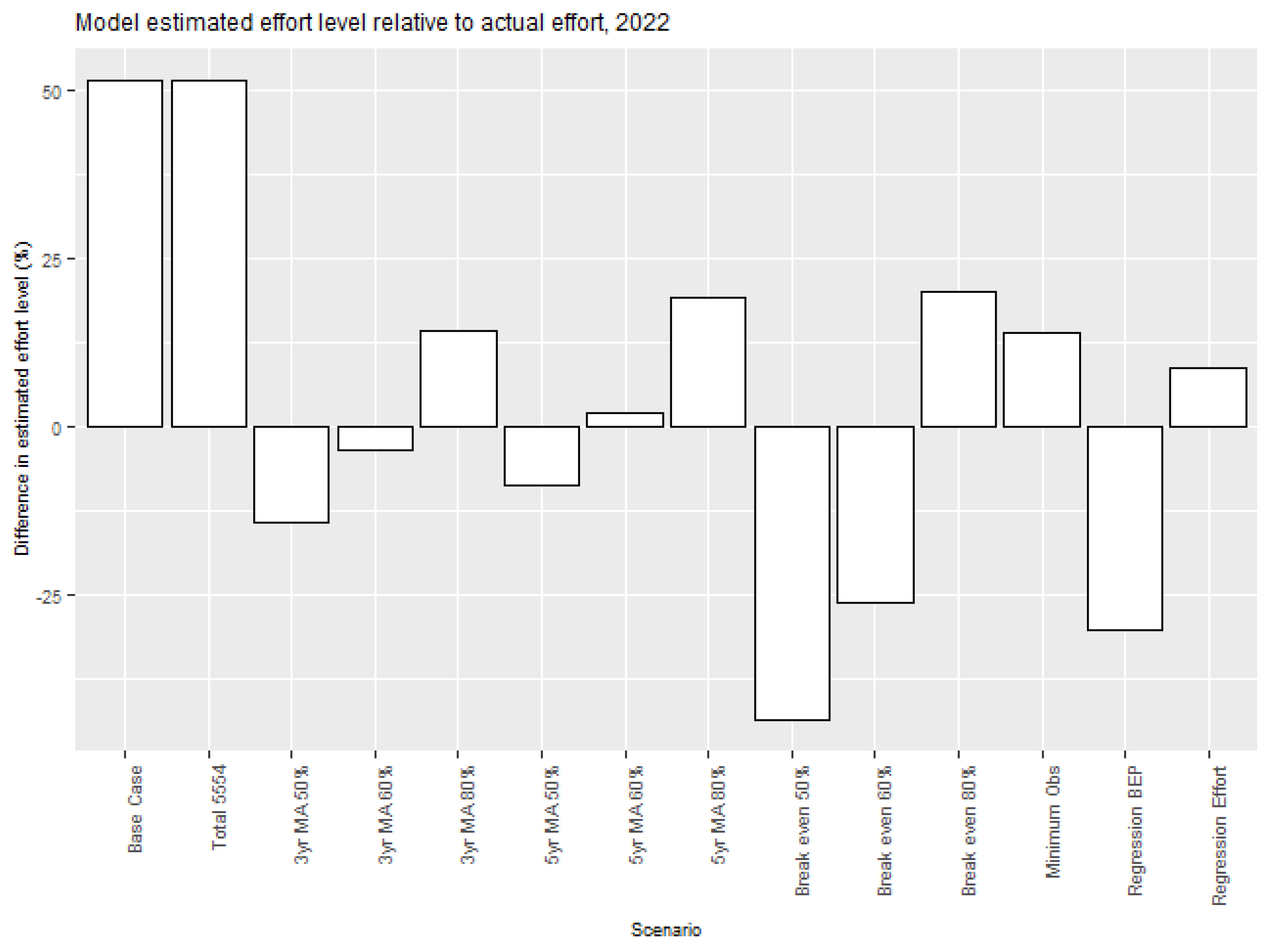
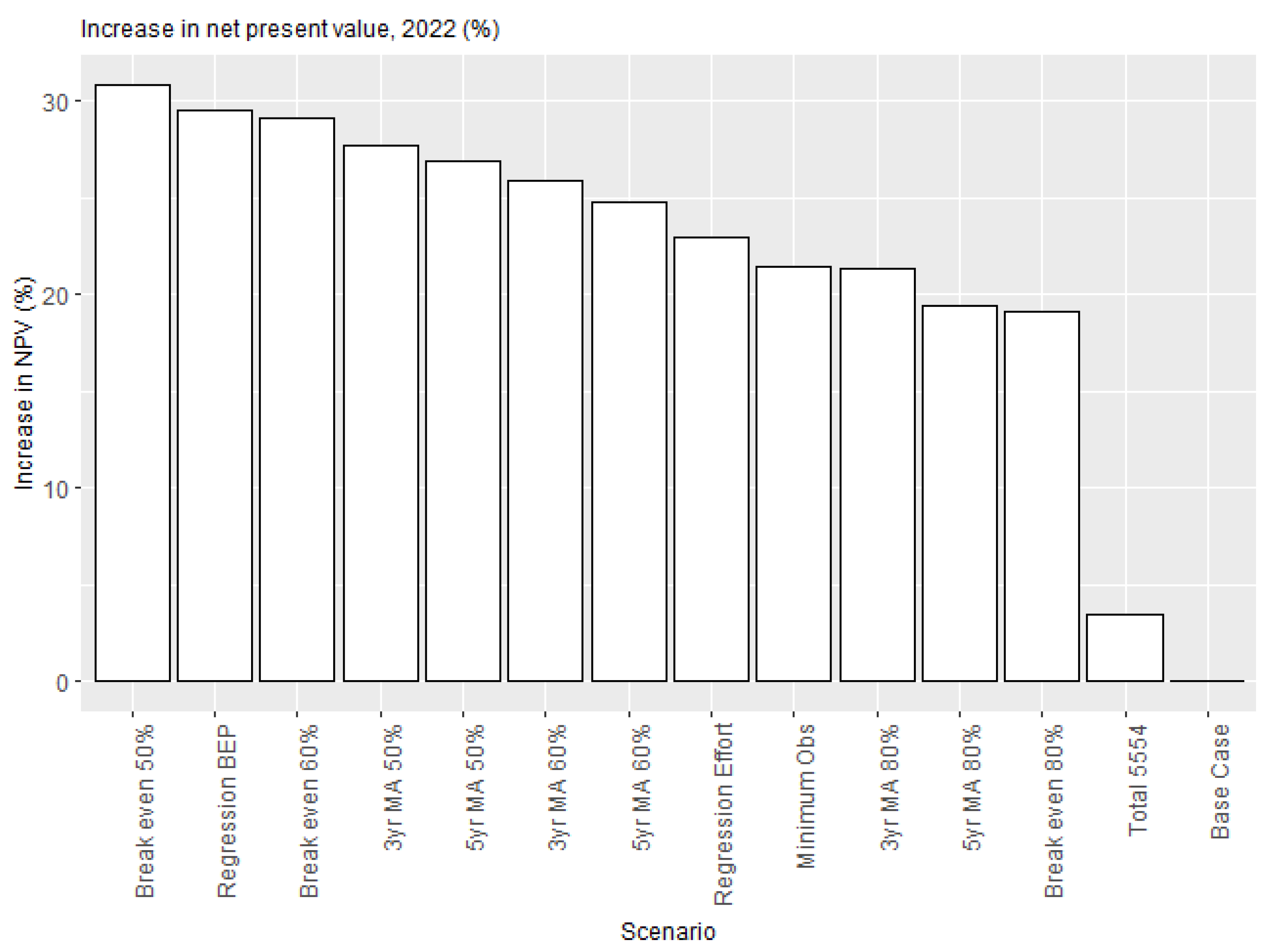

| Estimate | Std. Error | Significance | |
|---|---|---|---|
| Count model coefficients (negative binomial with log link): | |||
| Intercept | 7.013 | 0.271 | *** |
| Banana Prawn Revenue ($’000) | −0.005 | 0.000 | ** |
| Fuel cost per day ($’000) | 0.484 | 0.000 | ** |
| Log(theta) | 1.984 | 0.120 | *** |
| Zero-inflation model coefficients (binomial with logit link): | |||
| Intercept | −1.812 | 2.914 | |
| Fuel cost per day ($’000) | 0.928 | 1.775 | |
| Theta (dispersion parameter) | 7.27 | ||
| Log-likelihood on 6 Df | −64.29 | ||
| AIC | 140.58 | ||
| 3-Year Moving Average | 5-Year Moving Average | |||
|---|---|---|---|---|
| 2018 | 2022 | 2018 | 2022 | |
| Percentage of moving average | ||||
| 80% | 4241 | 3612 | 4316 | 3951 |
| 60% | 3181 | 2709 | 3237 | 2963 |
| 50% | 2651 | 2258 | 2698 | 2469 |
| Minimum observed (2007–2022) | 3599 | |||
| Estimate | Std. Error | Significance | |
|---|---|---|---|
| Intercept | 8.103 | 0.118 | *** |
| Log (Revenue less fuel cost per day, tiger prawn fishery) | 0.217 | 0.061 | ** |
| 0.471 | |||
| 0.433 | |||
| 12.49 | *** |
| 2018 | 2022 | |
|---|---|---|
| 5-year moving average | ||
| 80% | 4316 | 3951 |
| 60% | 3237 | 2963 |
| 50% | 2698 | 2469 |
| 3-year moving average | ||
| 80% | 4241 | 3612 |
| 60% | 3181 | 2709 |
| 50% | 2651 | 2258 |
| Breakeven probability | ||
| 80% | 4000 | 4000 |
| 60% | 1800 | 1800 |
| 50% | 1200 | 1200 |
| Regression models | ||
| Breakeven point model | 1670 | 1670 |
| Nominal Effort model | 3305 | 3305 |
| Minimum observed | 3599 | 3599 |
Disclaimer/Publisher’s Note: The statements, opinions and data contained in all publications are solely those of the individual author(s) and contributor(s) and not of MDPI and/or the editor(s). MDPI and/or the editor(s) disclaim responsibility for any injury to people or property resulting from any ideas, methods, instructions or products referred to in the content. |
© 2023 by the authors. Licensee MDPI, Basel, Switzerland. This article is an open access article distributed under the terms and conditions of the Creative Commons Attribution (CC BY) license (https://creativecommons.org/licenses/by/4.0/).
Share and Cite
Pascoe, S.; Deng, R.A.; Hutton, T.; Parker, D. Determining the Appropriate Minimum Effort Levels for Use in Fisheries Dynamic Bioeconomic Models. Sustainability 2023, 15, 16933. https://doi.org/10.3390/su152416933
Pascoe S, Deng RA, Hutton T, Parker D. Determining the Appropriate Minimum Effort Levels for Use in Fisheries Dynamic Bioeconomic Models. Sustainability. 2023; 15(24):16933. https://doi.org/10.3390/su152416933
Chicago/Turabian StylePascoe, Sean, Roy Aijun Deng, Trevor Hutton, and Denham Parker. 2023. "Determining the Appropriate Minimum Effort Levels for Use in Fisheries Dynamic Bioeconomic Models" Sustainability 15, no. 24: 16933. https://doi.org/10.3390/su152416933
APA StylePascoe, S., Deng, R. A., Hutton, T., & Parker, D. (2023). Determining the Appropriate Minimum Effort Levels for Use in Fisheries Dynamic Bioeconomic Models. Sustainability, 15(24), 16933. https://doi.org/10.3390/su152416933






